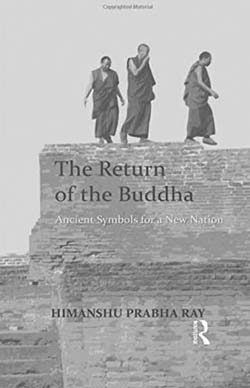Amaravati began to be developed as the capital of Andhra Pradesh last year, and the State’s creation of its new identity has involved an emphasis on its Buddhist past, at least partly to attract foreign investment. The Government of Andhra Pradesh also plans to set up a museum in Amaravati in memory of B.R. Ambedkar, who converted to Buddhism, but also interpreted its Pali canon afresh. The Amaravati project illustrates some of the themes that Himanshu Prabha Ray takes up in The Return of the Buddha. This book is, thus, a timely addition to the small number of monographs by historians of early India that break the disciplinary divide between the ‘ancient’ and ‘modern’ by exploring the modern histories of ancient sites and monuments.
It is well known that, while texts are invaluable sources for writing histories of religions, they should ideally be studied along with evidence from archaeology, inscriptions and coins. Ray has drawn on archaeological reports, studies of inscriptions and coins, archival material and newspaper articles to recount how material remains were used in the 19th and 20th centuries to write histories of Buddhism. In the early 19th century, western scholars initially focused on Hinduism, but Buddhism also received considerable scholarly attention in the 19th century, as it was evident that it had spread to vast areas of Central, East and Southeast Asia, among people who differed widely in terms of language and culture. While colonial officials saw the Hinduism of the 19th century as characterized by superstition, idol worship and caste oppression, they held up the Buddha as a rational and compassionate man who advocated social reform. They also regarded the ‘pure and practical’ message of the Buddha as distinct from later/‘degenerate’ Buddhism. Nineteenth-century scholars focused on the former, they concentrated on sites associated with the life of the historical Buddha and largely located in the Ganga valley. Far less attention was paid to other regions—the Western Himalaya and peninsular India, for instance. Ray shows how studying the archaeology of these areas enriches our understanding of the varied growth of Buddhism. While South India is known for the Hindu temple, she draws our attention to Buddhist sites such as Nagapattinam which flourished in the early medieval period when Hinduism is believed to have triumphed over Buddhism. Indeed, she points out that Nagapattinam even finds mention in a 15th century CE inscription of the Burmese king Dhammacheti as a place that some Burmese monks visited and worshipped at. Ray’s brief survey of archaeological remains in Bihar suggests that Buddhist sites also flourished in this region between the 7th and 15th centuries CE, and that they were in contact with one another and those in other parts of India and beyond. Thus, she counters the widely held belief that Buddhism started declining in India from around the 7th century CE and finally disappeared in the 11th/12th centuries CE. She also encourages us to see individual monastic centres not as discrete units, but as part of a large network of Buddhist sites linked by the movement of pilgrims, teachers and artistic connections.

